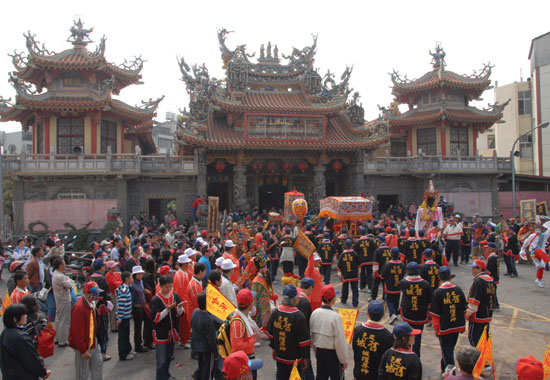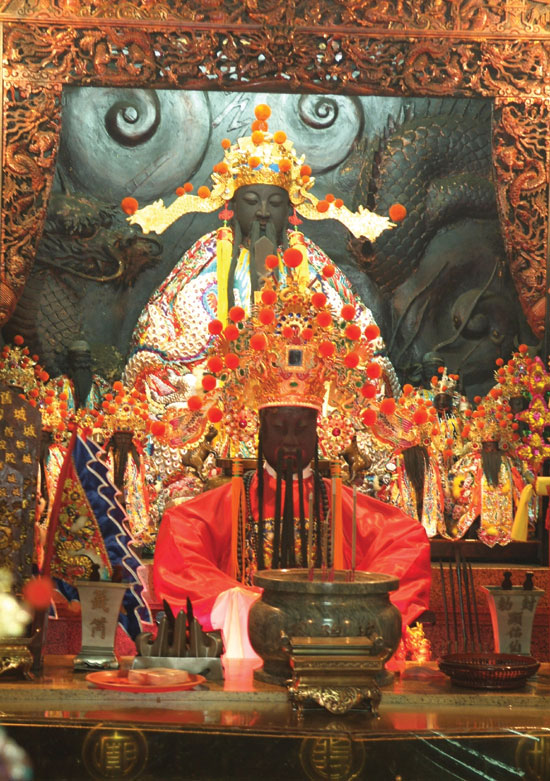Zuoying City God Temple / 左營鳳邑舊城城隍廟
Zuoying City God Temple
◎Text by Kuan-Chun Chen ◎Photo Courtesy of the City God Temple at the Old Fengshan city and Chung-Hui Pao
The six-day tour of the City God (Cheng Huang) of Zuoying finished officially on January 6. On that Sunday, thousands of pilgrims from other twenty-two City God temples of Taiwan gathered in the Lotus Pond neighborhood to express their respects to the City God, who has been listening to people's voice here since the Cing Dynasty.
According to Mao-Sheng Jhuang, the Chief Secretary of the City God Temple, the City God gave instruction about the tour and the starting date through the incense burning last year. Since the seven-day tour for celebrating the three hundred-year completion of the Temple in 1994, this is the first tour and demands a working staff of six thousand.
Before the tour, the leading gods patrolled in the temple court. Then, supporters lifted the sixty-kg golden City God statue from the black wooden palanquin and announced the start of the tour. During the six days of tour, the City God patrolled the eleven neighborhoods under his control. Areas include the Kezailiao in the north, south to the Pingtung Harbor, east to Dingjin and west to Neiwe in Kaohsiung. The tour exhibits the diverse religion art and people's love toward the City God.
On the last day of the tour, twenty-two City God statues from Taipei and Penghu gathered in the Lotus Pond neighborhood and were carried in turn to the temple court to show their respects. As the sound of gongs and drums and the fireworks thundered, the surrounding area was crowded by pilgrims and temple priests. The Tour Committee also prepared a dinner feast for everyone that night.
According to the Chief Secretary, the temple, rebuilt in 1968, was originally completed in 1704 and was just a cottage on the Pizihtou in Fongshan County.
During the Japanese colonial era, in order to promote its colonization policy, the Japanese government burned down the temple. However, the main statue remained unhurt. The golden main statue was about two hundred cm in height with movable limbs. After the World War II, the Japanese Government was collecting metals but still not dare to destroy the statue.
The golden statue, created by a Chinese sculptor, is the largest City God statue in Taiwan. Unlike other City God statues in Taiwan, this wooden statue has movable limbs because of the tenons inside. The palanquin of the City God was originally made of metal, but was later melted by the Japanese government to manufacture weapons. Therefore, in 1918, the palanquin was remade with black wood.
Inside the temple, there is a giant abacus on the beam of the temple. The abacus was carved with three words "Ask Your Heart" to remind the visitors to ask themselves if they have done things right when they enter the temple.
In addition, there's a couplet written by the honored scholar Jhao-Chang Jhuo in 1741. The main idea is: "Good deeds will be paid off with properity. If not, then your ancestors must have done something bad. When you pay off their debts, prosperity will come to you. Evil behaviors results in destruction. If not, your ancestors must have left you virtues. When their virtues are out, you will face destruction." This couplet indeed expresses the Chinese traditional karma concept and reminds everyone to always perform good deeds.
左營鳳邑舊城 城隍廟
◎文/小磊 ◎照片提供:鳳邑舊城城隍廟.鮑忠暉
 左營鳳邑舊城城隍廟主神軟身城隍爺,一月六日結束六天出巡,當天是週日,蓮池潭附近擠進上千名台灣22個城隍廟信眾,向這座自清朝康熙間即傾聽民間聲音的城隍爺致敬。
左營鳳邑舊城城隍廟主神軟身城隍爺,一月六日結束六天出巡,當天是週日,蓮池潭附近擠進上千名台灣22個城隍廟信眾,向這座自清朝康熙間即傾聽民間聲音的城隍爺致敬。
城隍廟董事會總幹事莊茂盛表示,去年城隍廟香爐「發爐」,經連續三次聖茭指示要出巡內外境,並指示日期。這是自民國九十三年建廟三百年繞境七日後,三年以來首度繞境,繞境期間,工作人員超過六千人。繞境前,文武判官、日夜巡神、功德爺、報司爺及牛馬將軍等廟內神明在廟埕巡繞,眾人「抬金身」,將近百斤的軟身城隍爺,從烏心木椅中抬起,並開始繞境。
六天期間,城隍爺巡視轄區十一個角落,晚間安營北至高雄縣蚵仔寮,南至屏東港,東至高雄市三民區覆鼎金,西至高雄市內惟區,展現宗教多元藝術以及民間的熱情參與。
結束繞境當天,包括台北及澎湖馬公城隍廟等22尊城隍爺集聚蓮池潭附近社區,各廟尊神由信眾抬轎至廟埕前依序致意,鄰近狹窄街道被信眾、廟祝與乩童擠滿,鑼鼓聲、炮聲齊鳴,晚間並由繞境委員會於街頭宴請辦桌。
廟方表示,舊城城隍廟於一九六八年改建完工,原廟建自一七○四年,當時清朝鳳山縣埤子頭街旁的一座草寮。
日據時代,日本推動皇民化政策,毀廟,但仍保有城隍爺金身,主神城隍金身,身高七尺六寸半(約兩百多公分),站立比常人高,手腳能動(軟身),二次大戰後期,日本政府毀廟籌湊戰爭銅鐵,當時警衛所長吉田景賀不敢毀壞神像。
這座城隍金身,創自唐山師傅之手,是目前台灣最大的,而且手、腳皆有木榫能活動的木雕城隍像,其餘城隍金身多為硬身,唯有左營城隍是可活動,左右上下360度與觀者凝視,無形中展放靈光。至於所坐神轎,原為銅鐵,日據時代熔做兵器,民國七年採烏心木雕重製至今。
廟方指出,除城隍金身外,參拜處屋樑上懸有一只巨型算盤,額刻「自問心」三個大字,提醒參拜者問神之前,需先捫心自問。
另外,廟內有西元一七四一年舉人卓肇昌對聯,「為善必昌,為善不昌,祖宗必有於殃,殃盡必昌;作惡必亡,作惡不亡,祖宗必有餘德,德盡必亡」,提醒參拜者行善、不作惡,充份顯示中國傳統福報觀念。